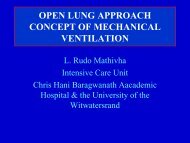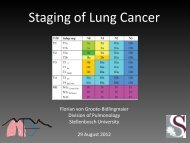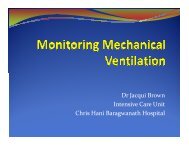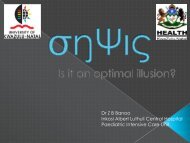Ari Leppäniemi Managing the open abdomen
Ari Leppäniemi Managing the open abdomen
Ari Leppäniemi Managing the open abdomen
You also want an ePaper? Increase the reach of your titles
YUMPU automatically turns print PDFs into web optimized ePapers that Google loves.
<strong>Managing</strong> <strong>the</strong> <strong>open</strong> <strong>abdomen</strong><br />
<strong>Ari</strong> Leppäniemi<br />
Department t of Abdominal Surgery<br />
Meilahti hospital<br />
University of Helsinki<br />
Finland
Frequency and causes of <strong>open</strong> <strong>abdomen</strong><br />
-in 23% (344/1531) after trauma laparotomies<br />
- damage control 66%, ACS 33%<br />
Miller 2005<br />
Trauma Vascular General<br />
Damage control 40% 9% 8%<br />
Planned re-explor. 23% 32% 65%<br />
Inability to close 19% 46% 13%<br />
IAP increase 16% 14% 7%<br />
Multifactorial 3% 0 8%<br />
Barker 2007
Open <strong>abdomen</strong> at Meilahti<br />
hospital 1997-2006<br />
n<br />
ACS<br />
Severe pancreatitis 17 11 (65%)<br />
Trauma/damage control 11 2<br />
AAA 10 2<br />
Abdominal sepsis 7 1<br />
Bowel ischemia 4 1<br />
Miscellaneous 8 4<br />
Total 57 21 (37%)
Outcome after <strong>open</strong> <strong>abdomen</strong> in trauma<br />
- n = 344, 68 (20%) died before wound closure<br />
- complications after wound closure (69/276 = 25%)<br />
- wound infection 16%, abscess 11%, fistula 12%<br />
- 34 (12%) died after wound closure<br />
- 7 (3%) from wound complication<br />
Miller 2005<br />
-n = 116, 10 (9%) died d before wound closure<br />
- 106 survived to wound closure (DFC 63%, SSG 37%)<br />
- abscess 5, fistula 4, evisceration 1, ACS 1, ileus 1<br />
Barker 2007
Classification of <strong>open</strong> <strong>abdomen</strong> (OA)<br />
1A Clean OA without adherence between bowel and<br />
abdominal wall or fixity it (lateralization li ti of abd. wall)<br />
1B Contaminated OA without adherence/fixity<br />
2A<br />
Clean OA developing adherence/fixity<br />
2B Contaminated OA developing adherence/fixity<br />
3 OA complicated by fistula formation<br />
4 Frozen OA with adherent/fixed bowel, unable to<br />
close surgically, with or without fistula<br />
Björck et al. WJS 2009;33:1154
Short- and dlong term aims in <strong>open</strong><br />
<strong>abdomen</strong><br />
- short-term aims (temporary abdominal closure)<br />
- close <strong>the</strong> “catabolic drain” of <strong>the</strong> <strong>open</strong> <strong>abdomen</strong><br />
- protect <strong>the</strong> viscera, prevent/manage fistulas<br />
- prevent bowel and fascial adherence<br />
- enable future fascial (and skin) closure<br />
- long-term aims<br />
- intact skin cover<br />
- fascial closure at midline, if possible<br />
- good functional outcome<br />
- no pain, good cosmetic result
Temporary closure of <strong>the</strong> <strong>open</strong> <strong>abdomen</strong> -<br />
what is <strong>the</strong> best method
Evolution of temporary abdominal<br />
closure techniques<br />
- first generation: abdominal coverage<br />
- running skin suture, towel clip<br />
- syn<strong>the</strong>tic cover (plastic, mesh etc.)<br />
- second generation: fluid control<br />
- vacuum pack<br />
- third generation: negative pressure <strong>the</strong>rapy<br />
- V.A.C.<br />
- ABThera<br />
De Waele and Leppäniemi 2011
Systematic ti review (3169 patients)<br />
t Mort. DFC Fist. Absc. [%]<br />
VAC 15 60 3 3<br />
Vacuum pack 27 52 6 4<br />
Wittmann patch 17 90 2 3<br />
Mesh or sheet 26 23 6 2<br />
Dynamic retention sutur. 23 85 nr nr<br />
Bogota bag (silo) 41 29 0 6<br />
Loose packing 39 11 28 nr<br />
Skin only 39 43 nr nr<br />
Zipper mesh/sheet 33 39 14 6<br />
van Hensbroek et al. WJS 2009;33:199
Comparative studies I<br />
- pre-patch (n=56) before 2004 (Bogota bag, vac pack, VAC,<br />
mesh) vs. patch (n=103) (Wittmann) 2004 onwards<br />
- early fascial closure 59% vs. 65% (p=ns)<br />
- remaining:<br />
pre-patch Patch p<br />
Delayed fascial closure 30% 78%
Comparative studies II<br />
- prospective randomized study, polyglactin mesh vs.<br />
VACx3+mesh (90% trauma, n=51-3 early deaths)<br />
VAC Mesh p<br />
Delayed fascial closure 31% 26% ns<br />
Abscess 44% 47% ns<br />
Fistula 21%* 5%** ns<br />
*all VAC fistulas related to feeding tubes and suture lines<br />
- avoid feeding jejunostomy, prefer nasojejunal tube<br />
**mesh fistula followed colon leak remote from <strong>the</strong> mesh<br />
Bee et al. 2008
Temporary mesh (mesh-assisted<br />
gradual closure)
Delayed primary fascial closure<br />
(%)
When to accept <strong>the</strong> hernia<br />
- re-explorations are no longer needed<br />
- conditions favoring planned hernia strategy<br />
- inability to reapproximate <strong>the</strong> retracted abdominal<br />
wall edges<br />
- sizeable tissue loss<br />
-risk of tertiary ti ACS, if primary closure attempted<br />
t - inadequate infection source control<br />
-anterior enteric fistula<br />
- poor nutritional status
Planned hernia<br />
- fascial defect with original skin cover<br />
- fascial replacement (mesh)<br />
- fascial approximation<br />
- combination<br />
- fascial and skin defect<br />
- component separation<br />
- split-thickness skin graft<br />
-granulation tissue and scar (VAC)
Mesh repair
Biological i l meshes<br />
- partially remodeling pros<strong>the</strong>ses<br />
- porcine dermal collagen, human dermal<br />
collagen, bovine pericardium collagen<br />
- completely remodeling pros<strong>the</strong>ses<br />
- porcine intestinal mucosa<br />
- different remodeling times<br />
- resistance to mechanical stress (partially remodeling<br />
meshes)<br />
- low adhesiogenic power <br />
- resistance to infection (contamination)
Components separation (Ramirez et al. 1990)
Planned hernia with early skin-grafting gat g
Abdominal wall reconstruction with<br />
Tensor fascia lata (TFL) -flap<br />
- myofascial or myofascial cutaneous flaps<br />
- pedicled TFL (Wangensteen 1934)<br />
- free vascularized TFL (Hill et al.1979)
Microvascular TFL-flap<br />
- n = 20, mean age 52 (range 43-78) years<br />
- mean follow up 5 (range 0.5-12) years<br />
- perioperative mortality 0<br />
- total flap necrosis 1<br />
- distal tip necrosis 2<br />
- postoperative p bleeding 1<br />
- intra- abdominal infection 0<br />
-deep surgical site infection 0<br />
- hernia recurrence (after 3 months) 1<br />
Tukiainen and Leppäniemi 2011
Management options (Leppäniemi & Tukiainen WJS 2011)<br />
Defect Primary Addit/alternat.<br />
Small hernia, intact skin<br />
No contamination CS Mesh (M)<br />
Contamination ti CS Biological i l mesh (Mb)<br />
Small hernia, grafted skin<br />
No contamination CS +M or flap<br />
Contamination CS +Mb or flap<br />
Large hernia, intact skin<br />
No contamination CS + flap or M<br />
Contamination CS + flap or Mb<br />
Large hernia, grafted skin<br />
No contamination Flap + CS + M<br />
Contamination Flap + CS + Mb
Conclusions<br />
- aim for delayed primary fascial closure<br />
- mesh-assisted VAC promising<br />
- if primary fascial closure not possible, planned hernia<br />
with early skin-graft<br />
- wait for <strong>the</strong> recovery of <strong>the</strong> patient and maturation of<br />
<strong>the</strong> skin-graft<br />
-choice of reconstruction ti method<br />
- component separation, TFL, + mesh<br />
- joint venture of abdominal and plastic surgeons !

















